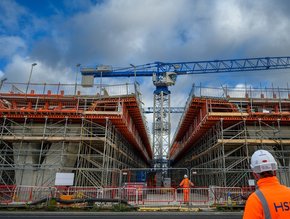How data visualization is transforming the construction industry in 2015

Big data is a concept that has impacted all industries, allowing corporations to define their futures more purposefully. The growing ability to process big data has created a period of more intuitive corporate leaders and more effective decision-making.
Despite the benefits that big data delivers, data processing at that magnitude isn’t necessary for all organizations. But, the same benefits can be reached by analyzing data on a smaller scale, opening up the opportunity to start seeing the benefits of data insights to small and medium sized companies.
What Is Small Data?
Enter what we call “small data.” The more common concern for companies in the Construction sector isn’t that they aren’t embracing big data, but they’re not doing enough to understand — let alone leverage — the powerful small data that literally drives their organization forward throughout the day.
Small data can categorized as sales data, profit, equipment up time, machinery down time, personnel productivity, asset life cycles, seasonal surges and dips…in other words, small data points can amount to a lot when it comes to monitoring, predicting and optimizing the overall health of the organization.
How do you tracking data now? Pen and paper? Excel? Some outdated and complicated database software?
Aside from the obvious technological shortcomings of such systems, these tracking mechanisms put companies at a strategic disadvantage. Critically, old methodology is only reliable in their ability to report past outcomes. At best, they can only record best guesses at future results.
What they can’t do is track and report on business performance in real time, nor reliably predict future performance based on timely and multiple data points that tell the complete story behind a company’s entire set of co-dependent operations.
Seeing is Believing
Before, companies would display the ever-present “Big Visual Chart” in the lunch room or board room…literally a poster board or similar chart, displaying either goals or targets hit. You may use some form of this today. Sales chart? Revenue growth?
Although one-dimensional, these charts played a key role in informing, not only management but rank-and-file as well, about the company’s targeted performance metrics. The main problems being that these charts were static, backwards-reflecting, and not actually associated with the systems that were really monitoring performance.
Now, the Big Visual Chart is a flat-screen monitor setup in various “water-cooler” locations across the office, that actually capture, process and report live data streams that intuitively and accessibly report performance metrics. These systems are dynamic, real-time, and completely customizable, provided you implement the appropriate technology into your various business systems.
Big data can wait. Data visualization cannot.
Companies that leveraged technology and implemented mildly sophisticated systems are finding that, through data visualization, managers and employees are seeing their company’s performance in real time. The result? Team members looking at real-time metrics unfolding before their very eyes are no longer having primary conversations about past results, but rather secondary conversations about strategy…and the future!
Why Adamo Went Mobile
One company in the Construction space has found firsthand how using data visualization tools can help inject enhanced quality, accuracy, accountability, efficiency, efficacy, predictability, profitability, cost and safety into the business. Adamo Group, based in Detroit, recognized that, in order to remain leaders in their space, they needed to transform their business processes to adapt to present realities and possibilities.
Adamo Demolition has a large employee base working in the field on projects offsite. Even the simple process of tracking hours and projects efficiently and accurately was becoming increasingly burdensome. Accuracy, accountability and efficiency are critical to a provider of eco-sensitive demolitions. The plan was to remove uncertainty and optimize the performance of their people, projects and processes — without adding layers of redundancy and bureacracy.
By tracking demolition teams to analyze personnel, machinery assets and projects to identify where greater efficiencies could be added, Adamo custom developed a system that empowers their people, processes and machinery in the field to track, report and analyze performance into a central system, which would both be powered by, and monitored with, mobile applications and devices.
The solution was a mobile-friendly Web application that allows workers to accurately log tasks, time and equipment used on projects via an end-to-end employee engagement program. This would prove to not only make project tracking and time-management more efficient and accurate, it served to optimize a business process that consumed a majority of each employee’s afternoon.
“When we told our employees about the new systems and processes, we got the initial reaction you’d expect.” says Denise Danneels, General Manager of Adamo Group. “Construction is an old industry and has many generations of people working together. At first, there was some resistance, but in practically no time, those reactions became, ‘Wow! This is a lot easier!’
“Within 60 days, we were fully functional on the new system, and had complete user buy-in. Now our employees are asking, ‘What else can this system do?!’”
What replaced past burdensome and inefficient processes was a fully automated and intuitively organized technology asset that would combine critical accountability and money-saving efficiency across the organization, positioning Adamo “light years" ahead of paper-and-pen competitors.
“Across the board, it’s been a huge success for our organization,” says Danneels. “I know it’s saving our employees time, and I know it’s saving us money because of the increased efficiency. It also injects enterprise-wide accountability, because now we don’t have to rely on someone telling us that something has been delivered or that a task has been completed. Instead, we can check our computers or phones and see tasks being completed in real-time.”
Data Visualization Transforms Small Data into Big Intelligence
By taking raw data, converting it into something attainable, then displaying that data to drive meaningful conversations is the difference between storing data and utilizing intelligence. It’s the difference between tracking past outcomes, and optimizing future performance!
At a time when companies are attempting to capture big data, and access to technology is endless, a majority of the Construction industry, still relies heavily on paper and reporting of past outcomes. But smart companies are working to decode data to provide real-time intelligence and analysis.
Ignoring buzzwords like “Big Data” may be easier than embracing change and exploring possibilities. And, in the case of big data, this may even be the sensible course for mid-sized construction and manufacturing firms. But companies in the Construction industry will ignore small data and data visualization at their own risk. Not only will you be watching archaic displays of incomplete and potentially inaccurate information about the health of your company, you may be observing your competitors—the modernizing few—pulling away from the pack.
Paul Tibbert is co-founder of GRID, a Troy, Mich.-based design and technology firm servicing manufacturing businesses across North America. For more information, visit www.workwithgrid.com, or contact Tibbert directly at [email protected].






